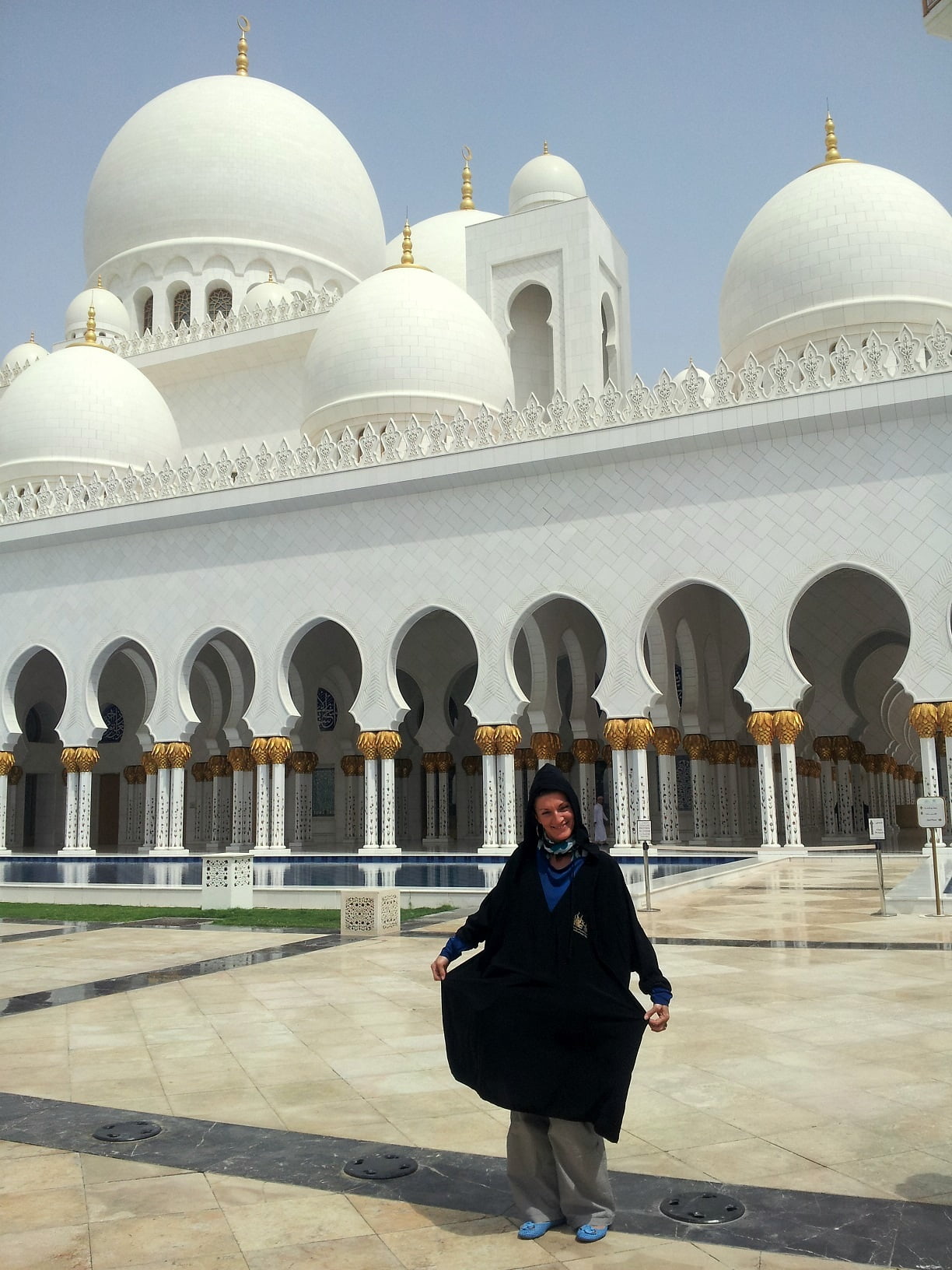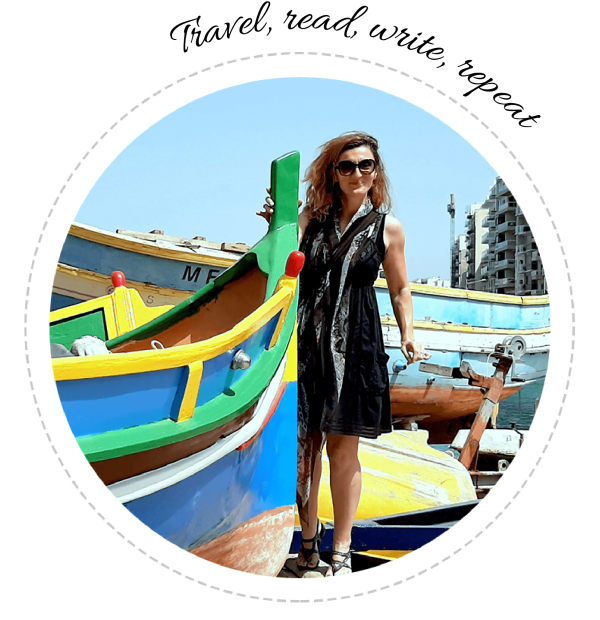
If you need a freelance travel writer or you would like to see your country, city, flight, etc., presented on the blog, drop me an email.
Find our more on Freelance Travel Writer page.
Here is my experience with the Abu Dhabi tour from Dubai. Well, let’s start from the beginning.
One of the things I promised myself to do if I ever set foot on Emirati soil was to visit the Sheikh Zayed Grand Mosque in Abu Dhabi. I watched a TV documentary a couple of years ago about how the mosque was built, and it looked so grand and surreal that it quickly climbed to my Top 20 bucket list. And there I was, in Dubai, just 150 kilometers away from Abu Dhabi!

It’s easy to take an Abu Dhabi tour from Dubai, either by booking through a travel agency or by going on your own. Day tours cost around 50 euros, with a minibus picking you up at your hotel, taking you to Abu Dhabi, stopping at several locations, and returning after about six hours. Of course, there’s always the chance of delays if the group isn’t ready on time. The other option is to travel independently, which is also quite simple. Regular bus lines run from Dubai (tickets cost 25 dirhams, or about 5 euros one way), and once in Abu Dhabi, you can easily navigate the city with taxis or maps. You can even rent a car for a reasonable price—after all, oil is cheap here. There’s no way to get lost since there’s only one highway cutting straight through the desert to Abu Dhabi.
But after bombarding the Filipino guides of the ‘open bus’ with countless questions, I asked a few more and learned that they also run tours to Abu Dhabi, which operate on the same principle as the ones in Dubai. Since I had already toured Dubai with them, the agency offered a discount for the Abu Dhabi trip, so the excursion only cost me around 30 euros. (Click on the link to see what Big Bus offers.)

The only problem is that the tour departs from Wafi at 8 in the morning, so you’ll need to get there by metro or taxi, and that’s where they drop you off on the way back as well. In Abu Dhabi, the return is at 5 pm from the Marina. So, whatever you manage to see in between.
My eyes went wide when they told me that the first stop, before entering the city, would be the Sheikh Zayed Grand Mosque, and that tourists are allowed inside at 10 am. ‘There will be a local guide, and they must bring appropriate clothing.’
This is something you don’t want to miss! I hurriedly pulled myself together, borrowing pants from friends living in Dubai (you can read more about that little anecdote in a separate piece about the Abu Dhabi mosque dress code). There was no time for last-minute shopping, so early in the morning, off we went to the white mosque.
Then, the laid-back attitude of the local agencies slowly starts to come to light. They said the bus from Wafi Mall leaves at eight, although its actual schedule is half-past eight, “because clients often tend to be late, so we tell them to be there earlier.” I still arrived 20 minutes early, and woke up who knows when to be on time, but okay, the reasoning makes sense.
I waited almost an hour for the departure, and asked again if we would still arrive at the Grand Mosque by 10, since they said that’s the only time we could enter—which is, after all, the main reason I’m going to Abu Dhabi in the first place.

“Don’t worry, ma’am, we’ll be there before 10,” one of the guides assured me.
So, I settled as comfortably as possible in the plastic seat, snapping pictures of the desert landscape on both sides of the highway, where the speed limit is 140 kilometers per hour.
An hour passed, and there was still nothing but sand… After an hour and a half, still just dry desert… It was already 10:30! If the mosque closed, this trip to Abu Dhabi would have been pointless! Our driver knew we were supposed to arrive by 10, but there was no guide on the bus to manage things. One had accompanied us from Dubai, and another was supposed to join at the first stop in Abu Dhabi.

Finally, the bus stopped in front of the mosque. Oh my, it looked even more magnificent than in the photos!
I didn’t even want to think about what would happen if we couldn’t get in, so I bombarded the Filipina with questions. She kept apologizing, saying, “It’s not up to me.” The driver had done his part, stepped out to have a smoke, and didn’t care. The only thing I managed to say was, “You don’t need to feel sorry, just please, make sure I get into that mosque tour that started half an hour ago.’
After many ‘I’m sorry’ and ‘I’ll check right away,’ I just rushed toward the mosque, leaving the bus, the driver, and the new guide behind. At the entrance, I found out that the mosque is actually open for tourist visits almost all day long. The tours led by local guides are free of charge and take place several times a day. One was scheduled for 11 am! (If only I had known, I wouldn’t have been so stressed.)

Rushing to the entrance, you’ll be greeted by a friendly Arab man who will direct you to the room where women pick up an abaya and men a dishdasha. (Make sure to read the previous text about the Abu Dhabi dress code and how I dressed for the occasion!)
The mosque itself is all white, with fountains on the sides, a multitude of pillars, and a vast courtyard adorned with marble patterns of flowers and leaves. You won’t know where to look first or what to photograph!
It’s unlike any other mosque I’ve seen in the Arab world (and I’ve seen quite a few – you might want to check out the one in Old Damascus, Syria). It actually resembles the Taj Mahal in India more than anything else. The mosque boasts 80 white domes, four minarets, and exactly 1,000 pillars, each topped with golden palm leaf motifs. Inside the smaller domes along the walkway, there are inscriptions from the Qur’an in three different styles of Arabic calligraphy. On the side, there’s a drinking fountain, an escalator leading to the underground restroom, and in the center, the main entrance. Tourists bustling around, a light breeze blowing, the white marble gleaming so brightly it almost blinds you, but that’s exactly what gives the place its surreal charm, surrounded by nothing but sand.

Local guides will lead you into the entrance hall, where a clock on the wall marks the times for all five daily prayers. Then, you’ll enter the vast prayer hall, where up to 7,000 worshippers can gather, not including the courtyard. During religious holidays, the entire mosque can accommodate around 40,000 people! The walls and floors between the pillars are adorned with motifs reminiscent of pearls, in keeping with the local tradition. A long Persian carpet, handwoven in Iran as a single piece, stretches over 5,400 square meters and was transported by train. The mosque is also known for its romantic arches and large, gold-plated chandeliers.
Sheikh Zayed himself is buried here. He passed away three years before the mosque opened its doors to worshippers in 2007.

After a few hours at the mosque and several hundred photos later, it was time to head back to the bus. While there wasn’t enough time to visit Ferrari World or Yas Island, we did manage to catch a glimpse of some of Abu Dhabi’s landmarks.
As we drove around, the guide pointed out the Marina, a much smaller area compared to Dubai, though Abu Dhabi is the capital.

Abu Dhabi holds 10% of the world’s known oil reserves, discovered in 1958. This discovery eventually led to the formation of the UAE in 1971, under the leadership of Sheikh Zayed bin Sultan al Nahyan.

It all began with the fall of the Muslim empires when the British and the Portuguese got interested in this Gulf region due to its strategic position in connecting Europe with India. Along with other emirates, Dubai was thus under the British control from 1892 not able to gain its independence until 1971 when the sheiks of both Dubai and Abu Dhabi decided to join all the emirates into a single state. Besides the two, there were also Ajman, Fujairah, Sharjah, Umm al Quwain, and Ras al Khaimah which joined a year later. The state thus incorporated the seven emirates. The chosen state leader was, as decided, the former chief of Abu Dhabi – Sheik Zayed bin Sultan al Nahyan I mentioned earlier.
We passed the city’s skyscrapers, the futuristic Al Itihad Square, and the famous Arab coffee kettle monument in front of Abu Dhabi Mall. We stopped by the Iranian market, the Corniche Fountain, some greenery along the promenade and the local beach. You can’t help but notice how parts of the city seem empty and dry, covered in sand and cranes.
We were shown „the biggest tourist settlement“, which was yet to be built and where they pointed towards the future museum „that will be erected to resemble the Louvre“.
The best view, however, is from the Observation Deck on the 74th floor of the Etihad Towers, which offers an incredible panorama of the city and the luxurious Emirates Palace Hotel below. I enjoyed the view of the Marina and the rest of the city from here. Another option for a coffee break, besides the Etihad Towers observation deck restaurant, is the Sky Tower Deck within the Marina Mall. This view will remind you how close the desert is.
After a few coffees and some small talk with fellow travelers, it was time to head back. Our guide smiled as we boarded the bus, offering us a “night tour” to see Dubai “in all its splendor” with a nice discount.
Images of Dubai at night flooded my mind—its buildings glowing softly, and the skyline barely discernible in the dark. Still, I could also recall the leisurely drivers and ever-apologetic guides…
“Thank you so much, maybe next time.”
Next: CRUISING THE CREEK
The full Dubai SERIES
PIN IT FOR LATER:
If you need a freelance travel writer or you would like to see your country, city, flight, etc., presented on the blog, drop me an email.
Find our more on Freelance Travel Writer page.
I am looking forward to working with you.



